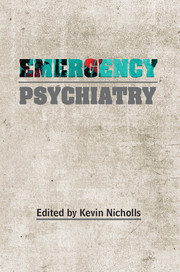Book contents
- Frontmatter
- Contents
- List of contributors
- Acknowledgements
- Preface
- 1 Assessment of suicide risk
- 2 Violence and aggression
- 3 Substance misuse emergencies
- 4 Alcohol and psychiatric emergencies
- 5 Acute psychosis
- 6 Acute side-effects of psychotropic medication
- 7 Emergencies in child and adolescent psychiatry
- 8 The psychiatric intensive care unit
- 9 Safeguarding
- 10 Emergency electroconvulsive therapy
- 11 Life-threatening medical emergencies in a mental health unit
- 12 Emergencies in intellectual disability psychiatry
- 13 Emergencies in older persons’ psychiatry
- 14 Perinatal psychiatric emergencies
- 15 Civilian and military psychological trauma
- 16 Emergencies in liaison psychiatry
- 17 Psychiatric emergencies in deaf people
- 18 Mental health law
- 19 Self-poisoning: aspects of assessment and initial care
- Index
2 - Violence and aggression
Published online by Cambridge University Press: 01 January 2018
- Frontmatter
- Contents
- List of contributors
- Acknowledgements
- Preface
- 1 Assessment of suicide risk
- 2 Violence and aggression
- 3 Substance misuse emergencies
- 4 Alcohol and psychiatric emergencies
- 5 Acute psychosis
- 6 Acute side-effects of psychotropic medication
- 7 Emergencies in child and adolescent psychiatry
- 8 The psychiatric intensive care unit
- 9 Safeguarding
- 10 Emergency electroconvulsive therapy
- 11 Life-threatening medical emergencies in a mental health unit
- 12 Emergencies in intellectual disability psychiatry
- 13 Emergencies in older persons’ psychiatry
- 14 Perinatal psychiatric emergencies
- 15 Civilian and military psychological trauma
- 16 Emergencies in liaison psychiatry
- 17 Psychiatric emergencies in deaf people
- 18 Mental health law
- 19 Self-poisoning: aspects of assessment and initial care
- Index
Summary
It is an uncomfortable truth that violence and aggression is a common occurrence in health settings. It has been argued that, among all occupational groups, ‘healthcare workers are ranked as one of the most likely groups to experience workplace aggression’ (Chappell & Di Martino, 2006). Anecdotally, there is a perception by many health workers that psychiatricunit staff are particularly prone to experiencing violence because of a perceived link between mental health problems and aggression. However, the reality is that violence and aggression is widespread in all medical settings (Hahn et al, 2008; Lepping et al 2013), with serious consequences for staff and patients.
In the management of such violence, healthcare staff commonly employ de-escalation techniques, but occasionally there is also a need for measures of restraint, including physical restraint, enforced medication and, in psychiatric settings, seclusion. These measures are often considered with great trepidation by staff and patients. There are a number of significant ethical issues with regard to restraint. Although most healthcare workers would consider proportionate restraint to be occasionally necessary, there are many who advocate that medicine should never use any form of restraint at all. However, most guidelines employed across the European Union allow proportionate, reasonable, appropriate and considerate restraint to avoid imminent harm. It is less clear to what degree restraint can occasionally be used beyond those limited circumstances. Keski-Valkama and colleagues (2010), for example, found that although agitation and disorientation were the most frequent reasons for the use of restraint and seclusion, the duration of those measures was not determined directly by the reasons for using them. They concluded that ‘clinical practice may deviate from theoretical and legal grounds established for such measures’. This exemplifies the importance of sound ethical structures and guidance around the use of restraint to manage violence and aggression (Steinert & Lepping, 2011).
Although it is obviously important to protect patients from inappropriate and unnecessarily long restraint measures, it is equally important for employers to protect their staff from workplace violence and assaults. In the UK, many initiatives of so-called ‘zero tolerance’ have been tried over the years, with limited success in reducing the incidence of violence.
- Type
- Chapter
- Information
- Emergency Psychiatry , pp. 12 - 31Publisher: Royal College of PsychiatristsPrint publication year: 2015



